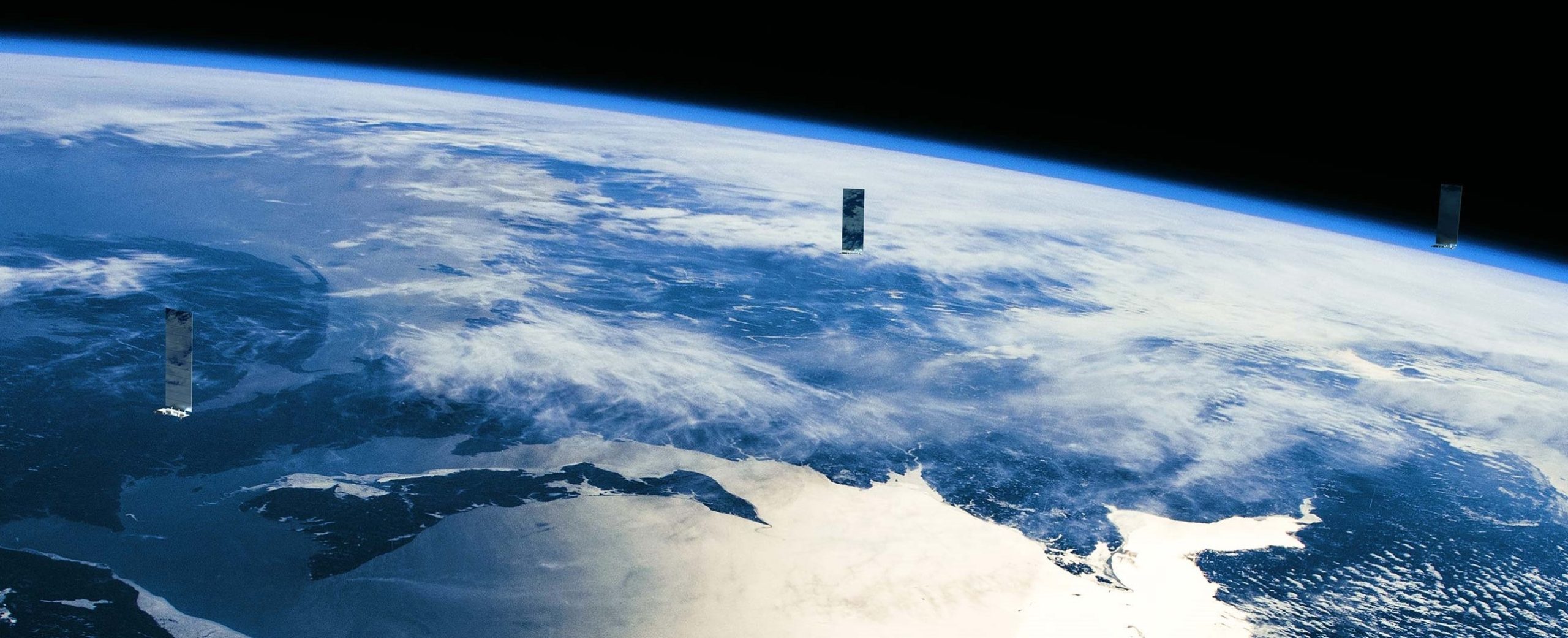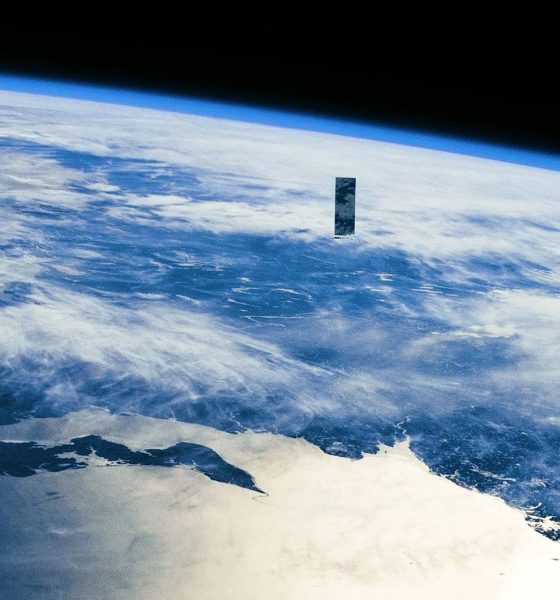

News
Livestream: SpaceX is about to launch its newest batch of Starlink satellites
SpaceX is ready to launch and land its reusable Falcon 9 booster just one month after an in-flight engine anomaly. Originally slated to occur April 16th, the Starlink-6 mission (seventh overall) sending the next batch of 60 flat-stack Starlink satellites to orbit slipped to Thursday, April 23rd following a successful static fire test of all nine Merlin 1D engines on Friday, April 17th.
However, weather conditions can sometimes be formidable in Florida. In a somewhat unprecedented move, SpaceX announced via the company’s Twitter account that the launch attempt would be moved up a day to Wednesday, April 22nd. The change allows the launcher to take advantage of more favorable weather conditions at the launch pad and recovery zone.
As identified by the 45th Weather Squadron of the Cape Canaveral Air Force Station, the launch opportunity window on Wednesday, April 22nd, provides a 90% chance of ‘GO’ weather conditions, while the now back-up launch opportunity on Thursday deteriorates drastically to only a 50% chance of appropriate launch conditions. The weather change is due to a cold front that is expected to drop through the state on Thursday.
Weather conditions at the recovery zone also proved to be more favorable for a Wednesday launch. On Wednesday’s the recovery weather conditions have a “low” amount of risk as assessed by the 45th Weather Squadron, while the back-up launch day of Thursday brings “high” risk. Overall, launching on Wednesday avoids the risk of potentially dangerous cumulus clouds and wind, both at the ground level and aloft in the atmosphere.
Wednesday’s launch attempt will also serve as a return to attempted landing and recovery procedures for SpaceX. Following two failed booster recovery attempts with the most recent Starlink missions, SpaceX hopes to nail recovery efforts of the booster and protective fairing nose one halves today.
Along with a re-used booster, the Starlink-6 mission features a re-used protective nose cone, called a payload fairing. Unlike previous Starlink missions that have flown with a re-used fairing, Starlink-6 features a fairing half that was caught in the net of one of the recovery vessels while the other half was recovered following a soft water landing. This will be the first time that SpaceX is utilizing fairing halves recovered by different methods. Until now, the recovered fairings that have been used were plucked from the water of the Atlantic ocean after a soft water-landing.
On Sunday, April 19th, the autonomous spaceport drone ship, Of Course I Still Love, departed Port Canaveral for the recovery zone some 629km downrange quickly followed by the fairing recovery vessels, GO Ms. Tree and GO Ms. Chief. If successful, SpaceX will have successfully launched and landed the B1051 Falcon 9 booster for a fourth time.
At time of article publishing, SpaceX announced via Twitter that the launch attempt had moved even further up to a targeted liftoff time of 3:30pm EDT/19:30pm UTC from LC-39A at Kennedy Space Center in Florida. SpaceX cover the launch live with a webcast scheduled to begin 15 minutes prior to launch found at https://www.spacex.com/webcast or viewed below.
Check out Teslarati’s Marketplace! We offer Tesla accessories, including for the Tesla Cybertruck and Tesla Model 3.

News
Tesla starts showing how FSD will change lives in Europe
Local officials tested the system on narrow country roads and were impressed by FSD’s smooth, human-like driving, with some calling the service a game-changer for everyday life in areas that are far from urban centers.

Tesla has launched Europe’s first public shuttle service using Full Self-Driving (Supervised) in the rural Eifelkreis Bitburg-Prüm region of Germany, demonstrating how the technology can restore independence and mobility for people who struggle with limited transport options.
Local officials tested the system on narrow country roads and were impressed by FSD’s smooth, human-like driving, with some calling the service a game-changer for everyday life in areas that are far from urban centers.
Officials see real impact on rural residents
Arzfeld Mayor Johannes Kuhl and District Administrator Andreas Kruppert personally tested the Tesla shuttle service. This allowed them to see just how well FSD navigated winding lanes and rural roads confidently. Kruppert said, “Autonomous driving sounds like science fiction to many, but we simply see here that it works totally well in rural regions too.” Kuhl, for his part, also noted that FSD “feels like a very experienced driver.”
The pilot complements the area’s “Citizen Bus” program, which provides on-demand rides for elderly residents who can no longer drive themselves. Tesla Europe shared a video of a demonstration of the service, highlighting how FSD gives people their freedom back, even in places where public transport is not as prevalent.
What the Ministry for Economic Affairs and Transport says
Rhineland-Palatinate’s Minister Daniela Schmitt supported the project, praising the collaboration that made this “first of its kind in Europe” possible. As per the ministry, the rural rollout for the service shows FSD’s potential beyond major cities, and it delivers tangible benefits like grocery runs, doctor visits, and social connections for isolated residents.
“Reliable and flexible mobility is especially vital in rural areas. With the launch of a shuttle service using self-driving vehicles (FSD supervised) by Tesla in the Eifelkreis Bitburg-Prüm, an innovative pilot project is now getting underway that complements local community bus services. It is the first project of its kind in Europe.
“The result is a real gain for rural mobility: greater accessibility, more flexibility and tangible benefits for everyday life. A strong signal for innovation, cooperation and future-oriented mobility beyond urban centers,” the ministry wrote in a LinkedIn post.
News
Tesla China quietly posts Robotaxi-related job listing
Tesla China is currently seeking a Low Voltage Electrical Engineer to work on circuit board design for the company’s autonomous vehicles.

Tesla has posted a new job listing in Shanghai explicitly tied to its Robotaxi program, fueling speculation that the company is preparing to launch its dedicated autonomous ride-hailing service in China.
As noted in the listing, Tesla China is currently seeking a Low Voltage Electrical Engineer to work on circuit board design for the company’s autonomous vehicles.
Robotaxi-specific role
The listing, which was shared on social media platform X by industry watcher @tslaming, suggested that Tesla China is looking to fill the role urgently. The job listing itself specifically mentions that the person hired for the role will be working on the Low Voltage Hardware team, which would design the circuit boards that would serve as the nervous system of the Robotaxi.
Key tasks for the role, as indicated in the job listing, include collaboration with PCB layout, firmware, mechanical, program management, and validation teams, among other responsibilities. The role is based in Shanghai.
China Robotaxi launch
China represents a massive potential market for robotaxis, with its dense urban centers and supportive policies in select cities. Tesla has limited permission to roll out FSD in the country, though despite this, its vehicles have been hailed as among the best in the market when it comes to autonomous features. So far, at least, it appears that China supports Tesla’s FSD and Robotaxi rollout.
This was hinted at in November, when Tesla brought the Cybercab to the 8th China International Import Expo (CIIE) in Shanghai, marking the first time that the autonomous two-seater was brought to the Asia-Pacific region. The vehicle, despite not having a release date in China, received a significant amount of interest among the event’s attendees.
Elon Musk
Elon Musk and Tesla AI Director share insights after empty driver seat Robotaxi rides
The executives’ unoccupied tests hint at the rapid progress of Tesla’s unsupervised Robotaxi efforts.

Tesla CEO Elon Musk and AI Director Ashok Elluswamy celebrated Christmas Eve by sharing personal experiences with Robotaxi vehicles that had no safety monitor or occupant in the driver’s seat. Musk described the system’s “perfect driving” around Austin, while Elluswamy posted video from the back seat, calling it “an amazing experience.”
The executives’ unoccupied tests hint at the rapid progress of Tesla’s unsupervised Robotaxi efforts.
Elon and Ashok’s firsthand Robotaxi insights
Prior to Musk and the Tesla AI Director’s posts, sightings of unmanned Teslas navigating public roads were widely shared on social media. One such vehicle was spotted in Austin, Texas, which Elon Musk acknowleged by stating that “Testing is underway with no occupants in the car.”
Based on his Christmas Eve post, Musk seemed to have tested an unmanned Tesla himself. “A Tesla with no safety monitor in the car and me sitting in the passenger seat took me all around Austin on Sunday with perfect driving,” Musk wrote in his post.
Elluswamy responded with a 2-minute video showing himself in the rear of an unmanned Tesla. The video featured the vehicle’s empty front seats, as well as its smooth handling through real-world traffic. He captioned his video with the words, “It’s an amazing experience!”
Towards Unsupervised operations
During an xAI Hackathon earlier this month, Elon Musk mentioned that Tesla owed be removing Safety Monitors from its Robotaxis in Austin in just three weeks. “Unsupervised is pretty much solved at this point. So there will be Tesla Robotaxis operating in Austin with no one in them. Not even anyone in the passenger seat in about three weeks,” he said. Musk echoed similar estimates at the 2025 Annual Shareholder Meeting and the Q3 2025 earnings call.
Considering the insights that were posted Musk and Elluswamy, it does appear that Tesla is working hard towards operating its Robotaxis with no safety monitors. This is quite impressive considering that the service was launched just earlier this year.








